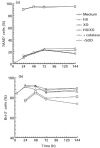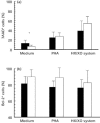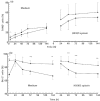Spontaneous and oxidative stress-induced programmed cell death in lymphocytes from patients with ataxia telangiectasia (AT)
- PMID: 10606975
- PMCID: PMC1905521
- DOI: 10.1046/j.1365-2249.2000.01098.x
Spontaneous and oxidative stress-induced programmed cell death in lymphocytes from patients with ataxia telangiectasia (AT)
Abstract
T cell lymphopenia in the peripheral blood lymphocytes (PBL) of patients with AT is mainly caused by a decrease of naive CD45RA+/CD4+ cells followed by a predominance of memory CD45RO+ lymphocytes. To relate these findings to the regulation of programmed cell death, we investigated the activation state and apoptotic level of PBL in 12 patients and healthy controls by flow cytometry. In accordance with previous investigations, the number of naive CD4+/CD45RA+ cells was significantly decreased in patients compared with healthy controls. This disturbed balance of CD45RA and CD45RO was also reflected in higher amounts of activated HLA-DR and CD95 expressing cells, with a concomitant decrease of Bcl-2 protected lymphocytes in the T cell population. With regard to its role in preventing oxidative-induced cell death, we analysed Bcl-2 expression and apoptosis in the presence of oxidative stress. In culture, cells of patients are more susceptible to spontaneous programmed cell death. However, in our stress-inducing system (hypoxanthine/xanthine oxidase system) the number of cells undergoing apoptosis was lower in patients' cell populations compared with controls. In addition, preliminary results suggest that Bcl-2 expression and level of spontaneous apoptosis in patients can be modified by IL-2 and interferon-gamma.
Figures






Similar articles
-
Selective deficiency of CD4+/CD45RA+ lymphocytes in patients with ataxia-telangiectasia.J Clin Immunol. 1992 Mar;12(2):84-91. doi: 10.1007/BF00918137. J Clin Immunol. 1992. PMID: 1373152
-
Deficiencies in CD4+ and CD8+ T cell subsets in ataxia telangiectasia.Clin Exp Immunol. 2002 Jul;129(1):125-32. doi: 10.1046/j.1365-2249.2002.01830.x. Clin Exp Immunol. 2002. PMID: 12100032 Free PMC article.
-
Classical ataxia telangiectasia patients have a congenitally aged immune system with high expression of CD95.J Immunol. 2012 Jul 1;189(1):261-8. doi: 10.4049/jimmunol.1101909. Epub 2012 May 30. J Immunol. 2012. PMID: 22649200
-
Abnormal distribution of CD45 isoforms expressed by CD4+ and CD8+ T cells in rheumatoid arthritis.Histol Histopathol. 2000 Apr;15(2):587-91. doi: 10.14670/HH-15.587. Histol Histopathol. 2000. PMID: 10809380 Review.
-
Neuroimmunodegeneration: do neurons and T cells use common pathways for cell death?FASEB J. 1995 Sep;9(12):1147-56. doi: 10.1096/fasebj.9.12.7672507. FASEB J. 1995. PMID: 7672507 Review.
Cited by
-
Systematic review and quantitative meta-analysis of age-dependent human T-lymphocyte homeostasis.Front Immunol. 2025 Jan 27;16:1475871. doi: 10.3389/fimmu.2025.1475871. eCollection 2025. Front Immunol. 2025. PMID: 39931065 Free PMC article.
-
DNA damage: a sensible mediator of the differentiation decision in hematopoietic stem cells and in leukemia.Int J Mol Sci. 2015 Mar 17;16(3):6183-201. doi: 10.3390/ijms16036183. Int J Mol Sci. 2015. PMID: 25789504 Free PMC article. Review.
-
Differential impact of neutrophil-to-lymphocyte ratio and time-weighted NLR on mortality and survival in critically ill children: insights from a retrospective study.Front Pediatr. 2025 May 20;13:1559405. doi: 10.3389/fped.2025.1559405. eCollection 2025. Front Pediatr. 2025. PMID: 40464042 Free PMC article.
-
Impaired interferon-gamma production in response to live bacteria and Toll-like receptor agonists in patients with ataxia telangiectasia.Clin Exp Immunol. 2006 Dec;146(3):381-9. doi: 10.1111/j.1365-2249.2006.03221.x. Clin Exp Immunol. 2006. PMID: 17100756 Free PMC article.
-
DNA damage response, redox status and hematopoiesis.Blood Cells Mol Dis. 2014 Jan;52(1):12-8. doi: 10.1016/j.bcmd.2013.08.002. Epub 2013 Sep 13. Blood Cells Mol Dis. 2014. PMID: 24041596 Free PMC article. Review.
References
-
- Gatti RA, Boder E, Vinters HV, Sparkes RS, Norman A, Lange K. Ataxia-telangiectasia: an interdisciplinary approach to pathogenesis. Medicine. 1991;70:99–117. - PubMed
-
- Lavin MF, Shiloh Y. Ataxia-telangiectasia: a multifaceted genetic disorder associated with defective signal transduction. Curr Opin Immunol. 1996;8:459–64. - PubMed
-
- Shiloh Y, Rotman G. Ataxia-telangiectasia and the ATM gene: linking neurodegeneration, immunodeficiency, and cancer to cell cycle checkpoints. J Clin Immunol. 1996;16:254–60. - PubMed
-
- Paganelli R, Scala E, Scarselli E, Ortolani C, Carmini D, Aiuti F, Fiorelli M. Selective deficiency of CD4+/CD45RA+ lymphocytes in patients with ataxia telangiectasia. J Clin Immunol. 1992;12:84–91. - PubMed
MeSH terms
Substances
LinkOut - more resources
Full Text Sources
Medical
Research Materials

